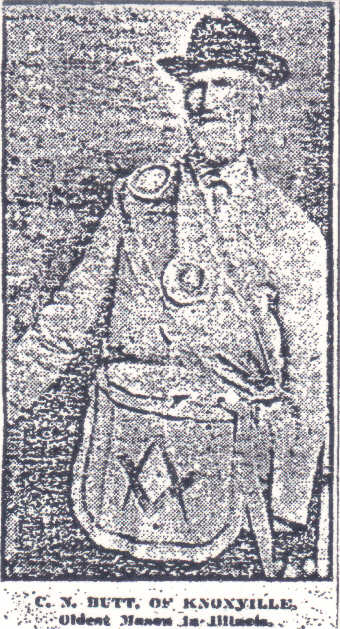|

May 4, 2020
#318
Thank you,
Barbara Schock, for sharing your extraordinary gift of these vignettes of Galesburg &
19th century American history.

Charles Norris Butt (1833-1919)
Knoxville, Illinois |
Recollections of a Pioneer By Barbara
Schock
On February 8, 1917, The Knox County Republican
published a reminisce written by Charles N. Butt in which he compared his
memories of the 1840s to the present day.
Charles N. Butt was born in Champaign County, Ohio, on
March 10, 1833. He was the tenth of eleven children in the family of Thomas D.
and Sarah (Williams) Butt, of Greenbrier, West Virginia. His parents came to
Knox County in 1837. He lived his entire life on the family farm six miles east
of Knoxville.
“Possibly it will be interesting to recall the times when
our people were not troubled about the high cost of living (World War One was
dominating world affairs at the time and prices had been increasing rapidly).
“The Butt farm consisted of 160 acres, the stock included
ten or twelve cows, a yoke of oxen, four mares, twenty-five head of sheep, a
dozen pigs, fifty hens, about a dozen geese, a few ducks and a flock or turkeys.
The farm produced practically everything the family consumed, both clothing and
food.
“The sheep furnished the wool which was carded at the
fulling mill into rolls for spinning. At home it was spun into yarn and woven on
a hand loom. For bed blankets it was left white, but for clothing it was dyed
any color desired. A competent housewife could make dyes of almost any color.
The white and black wool was mixed to produce a gray like the uniform of
Confederate soldiers in the Civil War. There was no ready-made clothing as all
clothing was made in the home. Stockings, mittens and tippets (scarves) were all
knitted in the home. Caps for the boys were made from furred animals which were
trapped in the winter time.
“Two or three cows were killed in a season. A tannery was
in operation near by and the hides were taken there and oak-tanned to make our
boots and shoes. A shoemaker would take measures of the whole family and make
our cowhides into boots.
“We sowed about an acre of flax and hemp for ropes, etc.
The flax we pulled, let it dry, then bound it up and put it out in the meadow to
rot the stalks to get the lint fiber. When in proper condition it was again
taken up and put in the shed until winter. The hemp was put through the same
process as the flax. Then it was put through a brake to break up the woody
stalks. Afterwards it was placed on a scutching board and the splinters knocked
out of the lint. After going through the hackle it was ready for spinning.
“Mother would spin the flax while the girls would spin
the wool. In the fall Mother would get enough cotton yarn for weaving the wool
into fabric for winter clothes. The flax was used to make sheets, towels and
summer wear. The flax seed was also used for a poultice to reduce swelling.
“For food we had everything we needed—fresh meat,
potatoes, beets, cabbage, parsnips, pumpkins for pies, apples, which produced
vinegar and cider. Six or eight hogs were killed in fall or early winter which
gave us plenty of meat for the winter, such as ham or spareribs, lard and
sausage. The hams and sides were salted in a big trough and in April they were
hung up in the smokehouse and smoked which prepared and preserved them for
summer use. We had plenty of chickens for summer roasting and pot pies and eggs,
turkeys for Thanksgiving and Christmas and a roasted goose occasionally, served
with applesauce.
“The cows gave plenty of milk and from it we made both
butter and cheese and what the family did not consume was taken to market at
Knoxville and traded for dry goods. Extra fine butter brought ten cents a pound,
cheese sold for five cents a pound. All eggs not used went to the store and they
brought five cents a dozen.”
Mr. Butt commented “Little was heard of the world at
large as there were no railroads, telegraphs or telephones. But the four-horse
stagecoach that ran from Peoria to Oquawka carried passengers and mail. Mail
carriers went on horseback across country.”
C.N. Butt and his wife are buried in the Knoxville
Cemetery. A large boulder taken from their farm marks the graves.
|
